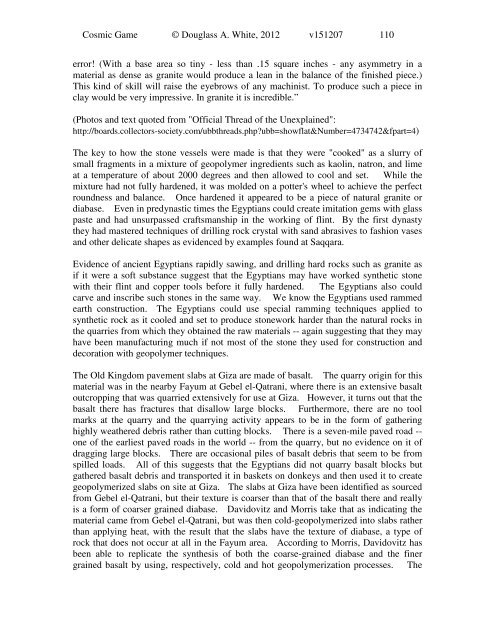Create successful ePaper yourself
Turn your PDF publications into a flip-book with our unique Google optimized e-Paper software.
<strong>Cosmic</strong> <strong>Game</strong> © Douglass A. White, 2012 v151207 110<br />
error! (With a base area so tiny - less than .15 square inches - any asymmetry in a<br />
material as dense as granite would produce a lean in the balance of the finished piece.)<br />
This kind of skill will raise the eyebrows of any machinist. To produce such a piece in<br />
clay would be very impressive. In granite it is incredible.”<br />
(Photos and text quoted from "Official Thread of the Unexplained":<br />
http://boards.collectors-society.<strong>com</strong>/ubbthreads.php?ubb=showflat&Number=4734742&fpart=4)<br />
<strong>The</strong> key to how the stone vessels were made is that they were "cooked" as a slurry of<br />
small fragments in a mixture of geopolymer ingredients such as kaolin, natron, and lime<br />
at a temperature of about 2000 degrees and then allowed to cool and set. While the<br />
mixture had not fully hardened, it was molded on a potter's wheel to achieve the perfect<br />
roundness and balance. Once hardened it appeared to be a piece of natural granite or<br />
diabase. Even in predynastic times the Egyptians could create imitation gems with glass<br />
paste and had unsurpassed craftsmanship in the working of flint. By the first dynasty<br />
they had mastered techniques of drilling rock crystal with sand abrasives to fashion vases<br />
and other delicate shapes as evidenced by examples found at Saqqara.<br />
Evidence of ancient Egyptians rapidly sawing, and drilling hard rocks such as granite as<br />
if it were a soft substance suggest that the Egyptians may have worked synthetic stone<br />
with their flint and copper tools before it fully hardened. <strong>The</strong> Egyptians also could<br />
carve and inscribe such stones in the same way. We know the Egyptians used rammed<br />
earth construction. <strong>The</strong> Egyptians could use special ramming techniques applied to<br />
synthetic rock as it cooled and set to produce stonework harder than the natural rocks in<br />
the quarries from which they obtained the raw materials -- again suggesting that they may<br />
have been manufacturing much if not most of the stone they used for construction and<br />
decoration with geopolymer techniques.<br />
<strong>The</strong> Old Kingdom pavement slabs at Giza are made of basalt. <strong>The</strong> quarry origin for this<br />
material was in the nearby Fayum at Gebel el-Qatrani, where there is an extensive basalt<br />
outcropping that was quarried extensively for use at Giza. However, it turns out that the<br />
basalt there has fractures that disallow large blocks. Furthermore, there are no tool<br />
marks at the quarry and the quarrying activity appears to be in the form of gathering<br />
highly weathered debris rather than cutting blocks. <strong>The</strong>re is a seven-mile paved road --<br />
one of the earliest paved roads in the world -- from the quarry, but no evidence on it of<br />
dragging large blocks. <strong>The</strong>re are occasional piles of basalt debris that seem to be from<br />
spilled loads. All of this suggests that the Egyptians did not quarry basalt blocks but<br />
gathered basalt debris and transported it in baskets on donkeys and then used it to create<br />
geopolymerized slabs on site at Giza. <strong>The</strong> slabs at Giza have been identified as sourced<br />
from Gebel el-Qatrani, but their texture is coarser than that of the basalt there and really<br />
is a form of coarser grained diabase. Davidovitz and Morris take that as indicating the<br />
material came from Gebel el-Qatrani, but was then cold-geopolymerized into slabs rather<br />
than applying heat, with the result that the slabs have the texture of diabase, a type of<br />
rock that does not occur at all in the Fayum area. According to Morris, Davidovitz has<br />
been able to replicate the synthesis of both the coarse-grained diabase and the finer<br />
grained basalt by using, respectively, cold and hot geopolymerization processes. <strong>The</strong>





